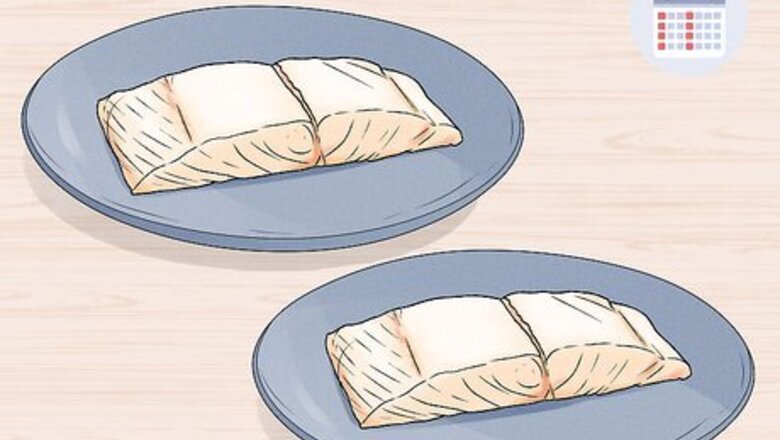
views
X
Research source
We know that there’s an overwhelming amount of fish to choose from, but we’ve picked a few healthy options and easy recipes you can try. As long as you balance fish along with your regular diet and keep up your workout routine, you’ll keep bulking up and getting stronger!
Serving Suggestions
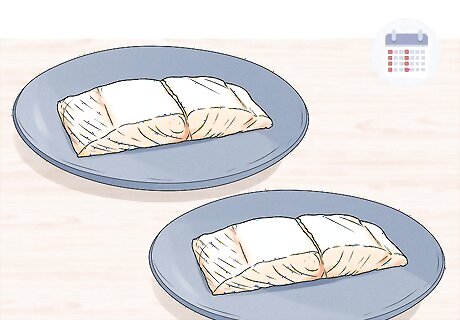
Eat at least 2 servings of white fish per week. White fish includes meats like cod, haddock, tilapia, pollock, and flounder, but there are many others to choose from. Since white fish has less fat than most red meats, it’s perfect for incorporating into your meals throughout the week. Try to make each portion around 4–5 ounces (110–140 g), which is about the same size as a deck of cards. You can have as much white fish during the week as you want except for varieties like sea bass, halibut, turbot, or rock salmon since they can contain harmful pollutants that build up in your body.

Incorporate 1 serving of oily fish into your weekly diet. Things like herring, salmon, sardines, trout, and mackerel are all oily fish. Oily fish are a little higher in fat, but they offer different nutrients like vitamin D and omega-3 fatty acids. These acids help prevent muscle loss and support growth hormones so you’re able to keep bulking up as you’re bodybuilding. On top of your 2 servings of white fish, include 1 meal that has a 5 oz (140 g) portion of oily fish. All oily fish have small levels of pollutants, such as mercury, that will build up in your body if you eat too much during the week. You should have no more than 12 ounces (340 g) of fish or seafood per week if you’re pregnant, trying to become pregnant, or breastfeeding.

Eat fish within an hour after exercising for the best results. Many studies show that if you have good sources of protein after a workout, your body will absorb it better and develop more lean muscle. Once you finish your routine for the day, have a protein-rich snack or meal within the next hour. You can also have protein before your workout to help you speed up recovery so you don’t feel as sore later on.

Balance out your proteins to reach your daily recommended value. Protein is important for repairing your muscles and helping you grow stronger, so it’s really important for bodybuilding. Multiply your weight in pounds by 0.5 g and 0.8 g to find the healthy range you should be eating. Your servings of fish will help contribute to how much protein you get, but you can also gain it from other sources, such as red meat, poultry, whole milk, eggs, or beans. Protein should account for about 10–35% of daily calories. For example, if you weigh 150 pounds (68 kg), you should aim to eat between 75 – 120 grams of protein daily. A 3 oz (85 g) piece of grilled salmon has about 22 grams of protein. Foods like beef, pork, fried chicken, ham, and deli meat are high in saturated fat, sodium, and cholesterol. On the other hand, fish is higher in healthy fats like omega-3s.
Types of Fish
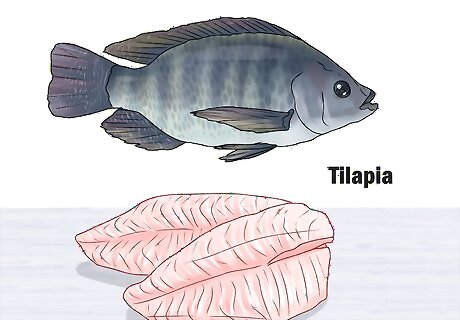
Eat cod or tilapia if you want a low-fat protein. Cod and tilapia are some of the most common fish you’ll find at your supermarket, and they’re perfect for your diet. Since they’re both white fish, they don’t have a lot of saturated fat and are really healthy. White fish also have a really versatile flavor, so you can use a variety of spices or marinades to make your meal even more delicious. Try baking or steaming these fish for the healthiest meal. A 3.5 oz (99 g) of cod has about 105 calories and 23 grams of protein. A serving of tilapia filet has around 110 calories and 23 grams of protein. Avoid deep-frying fish in oil since it will become a little unhealthier. You can always try pan-frying it in olive oil or another healthy oil to make it better for you. Try to buy Pacific cod if you can since Atlantic cod is overfished and caught with methods that harm other marine life.
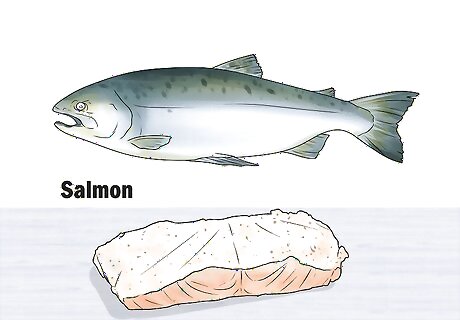
Try salmon or herring for a meal rich in omega-3s. On top of these fish being packed with protein, they have omega-3 fatty acids that improve your heart health. Our bodies can’t make omega-3s, so incorporating at least 1 or 2 meals per week with these fish can really improve your health. You can enjoy fresh filets or get canned varieties if you want something easier to prepare. You can grill, steam, or bake your fish to make your meal really nutritious. A 3.5 oz (99 g) serving of salmon contains about 200 calories and 22 grams of protein. A herring fillet contains around 290 calories and 33 grams of protein. Herring contains less mercury than other fish that are rich in omega-3s.

Have sardines or anchovies if you want a quick salty snack. If you’re looking for something smaller but still really nutritious, you can buy canned sardines and anchovies. Both of these fish have high levels of omega-3 fatty acids as well, so they’re more nutritious than white fish. These fish are usually precooked, so you can enjoy them on their own or use them as toppings on foods like crackers or even pizza. A 3.5 oz (99 g) serving of sardines has about 200 calories and 25 grams of protein. A similar serving of anchovies has 131 calories and 20 grams of protein. Sardines are usually pretty salty, so check the nutrition label to make sure you don’t exceed your daily sodium intake. Sardines might have bones, but they’re completely edible and a great source of calcium.

Enjoy tuna sparingly. Tuna is another fish that has a lot of omega-3, but it also can contain higher levels of mercury than other healthier varieties. If you do have tuna, try to get light canned tuna since it’s going to be the healthiest option. Yellowfin, Albacore, and bluefin tuna are usually much larger and contain more pollutants, so try to avoid them or limit yourself to 1 serving a week. Tuna tastes great straight out of the can, but you can grill or bake tuna steaks if you have them. A serving of light tuna that’s 1 cup (154 g) has about 179 calories and 39 grams of protein. If you’re pregnant, trying to become pregnant, or breastfeeding, limit yourself to no more than 4 ounces (110 g) of Albacore tuna per week to avoid high levels of mercury. Mercury can accumulate in your body and harm your baby.
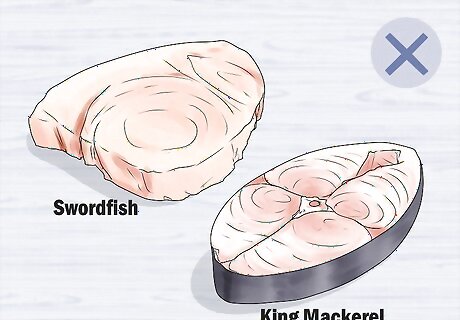
Avoid swordfish, shark, or king mackerel due to mercury contamination. There’s a small amount of mercury in all fish, but these species have higher concentrations than others. Since these fish are larger, mercury builds up in the meat and can make it unhealthier to eat. Do your best to cut these fish completely from your diet. These species are also endangered and overfishing them could lead to extinction.
Simple and Healthy Recipes
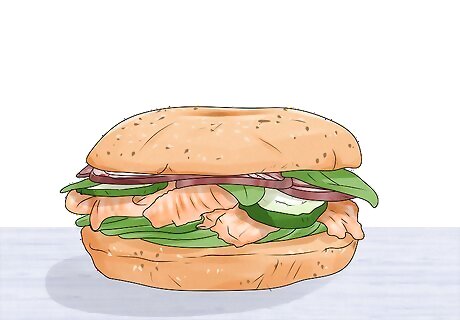
Try a smoked salmon bagel for a nutritious breakfast. Take a plain bagel and cut it horizontally so you can add your toppings. Spread about 1 tablespoon (15 g) of cream cheese onto each half of the bagel. Then you can add toppings like cucumber slices, red onion, and capers on top of the bagel. Finish the bagel off with about 3 ounces (85 g) of thinly sliced salmon for a simple but tasty meal. You can also try adding tomato slices, chives, and scallions to your bagel to enhance the flavor even more.
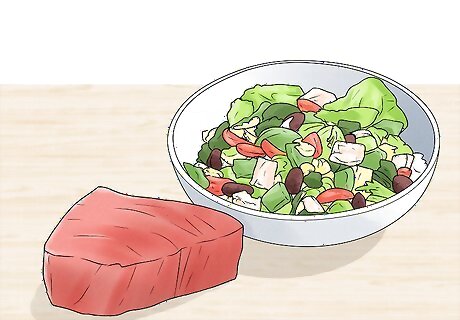
Mix tuna into a salad to make a healthy lunch. If you’re looking for a light yet filling meal, toss mixed greens in a bowl with some chopped tomato, olives, zucchini, avocado, and onions. Open a can of light tuna and drain the liquid before mixing it into the salad. Top your meal with a light vinaigrette or dressing and enjoy! Feel free to add whatever vegetables you want to your salad if you want to try different flavors. Incorporate some chopped herbs, like parsley and mint, to add even more freshness to your meal.
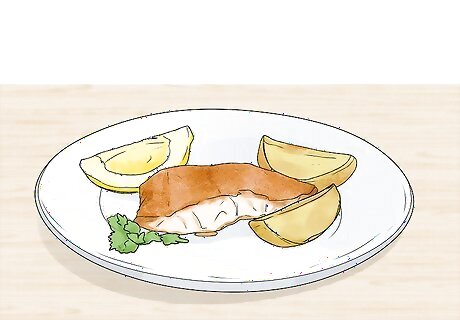
Have baked fish if you want a simple dinner. You can use this recipe for any type of fish, so pick out a few filets of your favorite. Preheat your oven to 400 °F (204 °C) and let it warm up. Rip off a large piece of aluminum foil and put a pile of fresh spinach in the middle. Set your fish on the spinach and season it with salt and pepper. Top your fish with ingredients like lemon, onion, or fresh time to infuse the flavors. Wrap the foil around your fish and put it in your oven for about 20 minutes. Check that your fish reaches an internal temperature of 145 °F (63 °C), or else you might be at risk for foodborne illnesses. Baked fish pairs really well with roasted vegetables and freshly made bread.
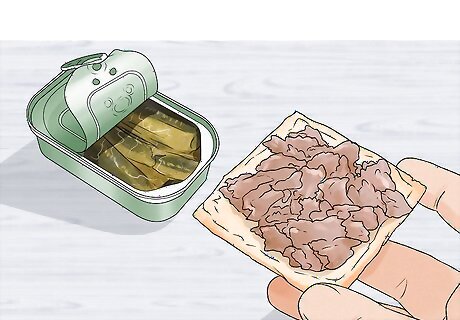
Eat sardines with whole-grain crackers when you need a quick snack. Take a few sardines out of the can and put them on top of your favorite crackers. If you want to enhance the flavor even more, try drizzling on some lemon juice or olive oil and adding tomatoes and basil as toppings. Just make sure that you check the nutritional information on your fish since they can be really high in sodium.













Comments
0 comment